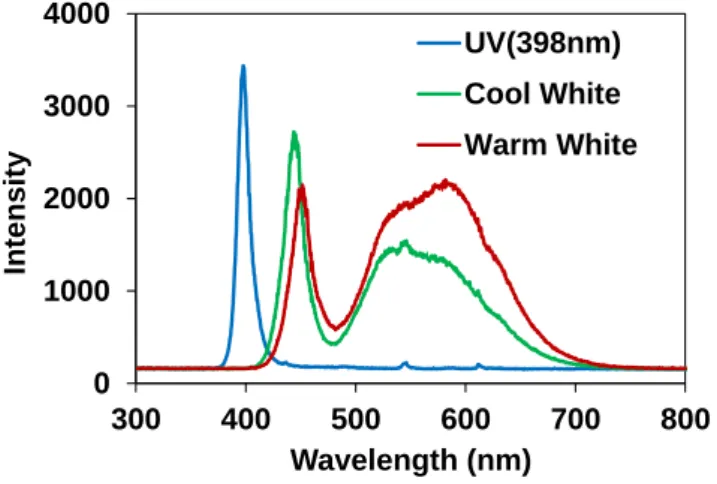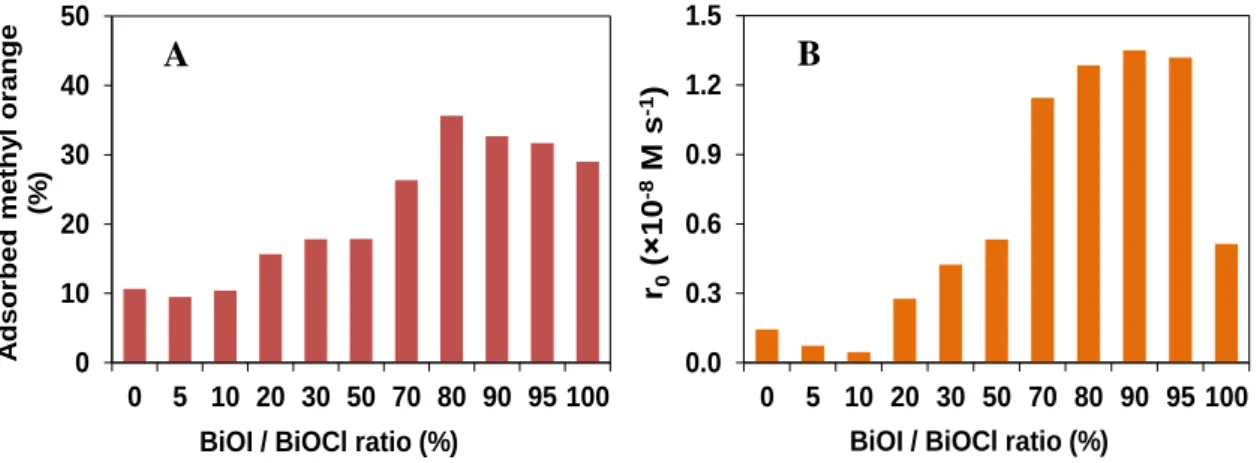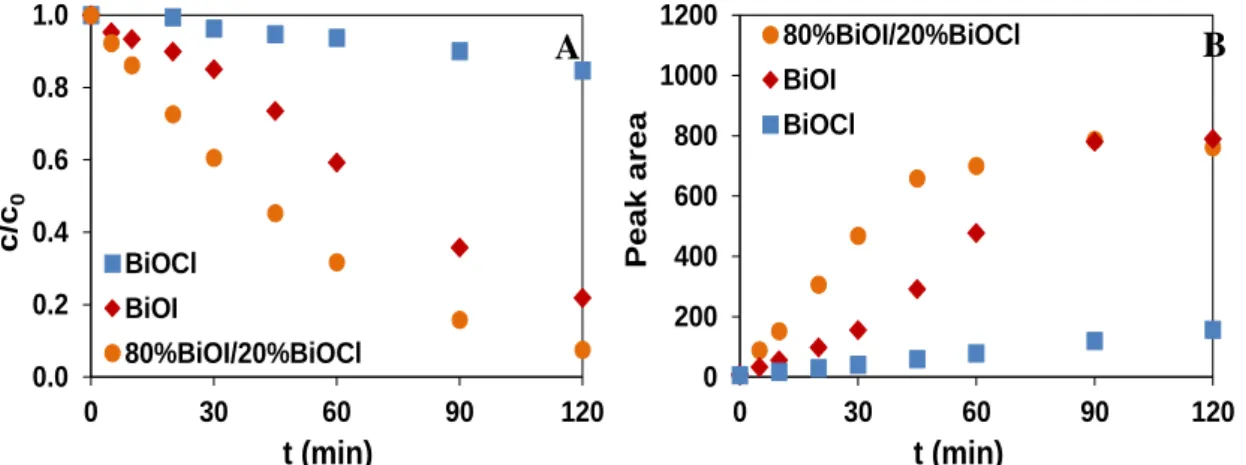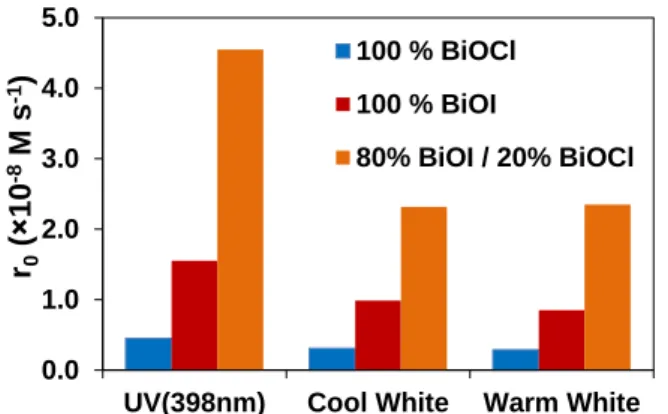389
BiOCl/BiOI COMPOSIT PHOTOCATALYSTS – INVESTIGATION OF THEIR EFFICIENCY USING UV AND VISIBLE LED LIGHT SOURCES
Tamás Hlogyik1, Máté Náfrádi1, Klára Hernádi2, Tünde Alapi1
1Department of Inorganic and Analytical Chemistry, University of Szeged, H-6720 Szeged, Hungary Dóm tér 7., Hungary
2Department of Applied and Enviromental Chemistry, University of Szeged, H-6720 Szeged, Rerrich Béla tér 1.
e-mail: tamas.hlogyik@gmail.com
Abstract
Due to its unique layered structure, bismuth oxyhalide (BiOX, where X=F, Cl, Br, I) has potential applications as a photocatalytic material in clean energy utilization and environmental purification. In this work, BiOI, BiOCl, and their composites with various BiOI:BiOCl molar ratios were synthesized and characterized for their heterogeneous photocatalytic applications.
The methyl orange was used as a model pollutant and UV and visible LED light sources were applied. Adsorption measurements and photocatalytic tests proved that, the BiOI/BiOCl composite, which contains 80% BiOI and 20% BiOCl, showed the best activity. The composite catalyst showed good activity under visible light and was particularly better than pure BiOI and BiOCl under UV radiation. The transformation mechanism of methyl orange is initiated by direct charge transfer processes, via photosensitization.
Introduction
The removal of trace amounts of organic pollutants from drinking water is one of the great challenges in water treatment technologies. Advanced oxidation processes (AOPs) based on the formation of reactive particles, as additive water purification methods can offer a solution to remove these substances. Heterogeneous photocatalysis is a widely studied process, mainly for the removal of organic pollutants having low concentration. The process is based on the excitation of a semiconductor, resulting in the formation of excited conduction band electrons (ecb-) and valence band holes (hvb+) [1]. The degradation of pollutants can be initiated by the direct charge transfer photogenerated charges and substrates adsorbed on the surface, and/or via radical based reactions. The photosensitization can also play a significant role [2].
Besides the well-known photocatalysts, such as TiO2 and ZnO [3], a number of new photoactive materials have been developed and studied during the last decades, especially for the harvesting of visible light, as sunlight is the cheapest light source. The synthesis, characterization and activity analysis of new types of photocatalysts are particularly important, as the most common TiO2 and ZnO require UV radiation (<400 nm).
Bismuth oxyhalide (BiOX, where X=F, Cl, Br, I) photocatalysts have been extensively studied in the last few years as potential photocatalysts, some of them can be excited with visible light.
[4]. Bismuth oxyiodide (BiOI) shows the best photocatalytic activity in the visible region, which is explained by the relatively small band gap of the semiconductor (1.8 eV). To increase their stability and activity, various BiOX catalysts were prepared. Li et al. [5] and Zhong et al.
[6] used BiOCl/BiOI composites, and successful applied for the elimination of various dyes from aqueous solutions under visible light radiation.
An important technical part of heterogeneous photocatalysis is the selection of the appropriate light source. In the recent years, the use of Light Emitting Diode (LED) has become more and more popular, due to their lower prices, longer lifetime (with proper operation), higher mechanical tolerance and lower electrical energy consumption, they represent a promising alternative to mercury vapor and xenon lamps.
390
The main goal of this work was the synthesis of BiOI/BiOCl composite catalysts for operation in the visible light region. The transformation of a widely used test compound, methyl orange was investigated. The commercially available LED light sources were used as light source: the application of UV-LED (398 nm) and two other LED light sources, which emit visible light (Cool white and warm white), were investigated and compared.
Experimental
The BiOI/BiOCl photocatalysts were prepared as described in the literature by Bárdos et al. [7].
Bi(NO3)3 × 5 H2O (Alfa Aesar, 98 %), KCl and KI (Molar Chemicals, 99.7 %) were used and the photocatalysts were prepared via solvothermal method. The Bi(NO3)3 × 5 H2O, KCl and KI (in the appropriate proportions) were dissolved in 50 ml ethylene glycol (Sigma-Aldrich, 99.95%). The crystallization was performed at 120 °C in a PTFE autoclave for 3 hours. The solid material was washed with distilled water and ethanol (VWR, 96%), then filtered through 0.1 μm pore size filter (Durapore®, hydrophilic PVDF). The solid material was dried for 24 hours of at 40 °C.
During the photocatalytic experiments, 100 cm3 suspension was irradiated in a cylindrical glass reactor (inner diameter: 45 mm). The concentration of BiOI/BiOCl photocatalysts was 0.5 g dm-3. Methyl orange (2.0×10-4 M) was used as a model compound, in each cases. As light source, UV (LEDmaster, 288 lumen, 4.6 W), cool white (LEDmaster, 390 lumen, 4.6 W), and warm white (LEDmaster, 600 lumen, 4.6 W) LED tapes were used, their emission spectra are shown on Fig. 1. The length of the LED tape was 1 meter in each case. The reactor was equipped with a water cooling system. The LED tape (60 LED/m) was fixed on the inner wall of the cooling jacket, which was made from aluminum tube, having 66 mm inner diameter.
Figure 1. Emission spectra of the LED light sources
Methyl orange is adsorbed well on the photocatalysts surface. After sampling, 0.5 cm3 NaF solution (0.5 M) was added to 1.0 cm3 sample for desorption of methyl orange from the surface of the photocatalyst. The samples were centrifuged (Dragonlab, 15000 RPM) and catalysts were filtered with syringe filters (0.22 µm, FilterBiO, PVDF-L).
An Agilent 8453 UV-Vis spectrophotometer was used for spectrophotometry measurements.
The absorbance of the samples was measured at 464 nm (the maxima of the methyl orange spectrum) in a 2.0 mm quartz cuvette. For separation of the intermediates and determination of methyl orange concentration in treated solution HPLC (Agilent 1100 HPLC equipped with a DAD detector) was used. As a stationary phase, a Kinetex 2.6u XB-C18 100A (Phenomenex) reverse phase column was applied, while the mobile phase consisted of 40 v/v% acetonitrile (VWR, UPLC-grade) and 60 v/v% formic acid solution (0.1%).
0 1000 2000 3000 4000
300 400 500 600 700 800
Intensity
Wavelength (nm) UV(398nm) Cool White Warm White
391 Results and discussion
Pure BiOCl, BiOI and BiOI/BiOCl photocatalysts with different molar ratios have been synthesized. In the case of the composites, the BiOI content changed from 5% to 95%.
Adsorption generally has an important role during heterogeneous photocatalysis, especially in the case of dyes. The adsorption capacity of photocatalysts was determined in 0.5 g dm-3 suspension containing 1.0×10-4 M methyl-orange, after 2 h stirring in the dark. Adsorption equilibrium was reached after 30 min. The adsorption capacity of BiOI (29 % of the initial concentration of methyl orange; 1.16×10-3 mol/g) is highly exceed that of BiOCl (11 % of initial concentration methyl orange; 4.3×10-4 mol/g). The amount of adsorbed methyl orange increased with increasing the BiOI content, up to 80:20 molar ration of BiOI:BiOCl, when 37
% of methyl orange was adsorbed. After that, it slightly decreased (Fig. 2).
Figure 2. Adsorption capacity for methyl orange (A), and the transformation rates in the case of different BiOCl/BiOI composites
The photocatalytic activity of the synthetized materials were investigated under UV-LED radiation for 2 hours. The pure BiOCl showed negligible activity due to its wide band gap (3.2 eV), but methyl orange was effectively transformed in the case of BiOI. The highest transformation rates (r0) were measured in the case of catalysts with 70-95 % BiOI/BiOCl molar ratios, as the initial reaction rates were nearly 3 times higher, than for BiOI. For further experiments, the sample containing 80:20 BiOI:BiOCl molar ratio was used.
The UV-Vis absorption spectra of the samples shifted to the shorter wavelengths during the transformation of methyl orange (Fig. 3/A). Due to the formation of products having significant absorbance at 464 nm, the concentration of methyl orange was determined by HPLC-DAD method. The transformation rate determined from chromatographic data was significantly higher, than the rate of absorbance decrease (Fig. 3/B).
0.0 0.3 0.6 0.9 1.2 1.5
0 5 10 20 30 50 70 80 90 95 100 r0( 10-8M s-1)
BiOI / BiOCl ratio (%) 0
10 20 30 40 50
0 5 10 20 30 50 70 80 90 95 100 Adsorbed methyl orange (%)
BiOI / BiOCl ratio (%)
A B
392
Figure 3. The absorption spectra (A), the relative absorbance of the treated solution and the relative concentration of methyl orange determined by HPLC-DAD method (B) in the case of
80:20 BiOI:BiOCl composite, under UV (398 nm) radiation
Figure 4. The relative concentration of methyl orange (A) and the peak area of its degradation product (B) as a function of time in the case of BiOI, BiOCl and 80:20 BiOI:BiOCl
composite, under UV (398 nm) radiation
The transformation of methyl orange and the formation of its main product were compared in the case of BiOI, BiOCl, and the composite catalysts having 80:20 BiOI:BiOCl molar ratio (Fig. 4.). The activity of BiOCl was negligible, while BiOI and the composite showed similar results after 120 minutes. However, the transformation of methyl-orange, and the formation of the product started much slower in the case of BiOI than in the case of the composite catalyst:
In the case of BiOI an induction period can be observed on the kinetic curve.
The measurements were performed with the cool white and warm white LED light sources (Fig.
5.). The composite photocatalyst was found to be the most effective in the case of each LEDs, but two times higher transformation rate was determined in the case of the UV radiation.
Despite its wide band gap, BiOCl showed some photocatalytic activity, even under visible light radiation, which refers to the photosensitization in the transformation of methyl orange.
0.0 0.2 0.4 0.6 0.8 1.0
0 30 60 90 120
Abs / Abs0; c / c0
Tengelycím HPLC-DAD
Spectrophotometry 0.0
0.2 0.4 0.6 0.8 1.0
300 350 400 450 500 550 600
Absorbance (A.U.)
Wavelength (nm)
0 min 5 min 10 min
20 min 30 min 45 min
60 min 90 min 120 min
464 nm
0.0 0.2 0.4 0.6 0.8 1.0
0 30 60 90 120
c/c0
t (min) BiOCl
BiOI
80%BiOI/20%BiOCl
0 200 400 600 800 1000 1200
0 30 60 90 120
Peak area
t (min) 80%BiOI/20%BiOCl BiOI
BiOCl
A B A
B
393
Figure 5. Reaction rate of methyl orange transformation in the case of BiOI, BiOCl and 80%
BiOI-20% BiOCl and different UV and Vis-LED irradiation
Conclusions
BiOCl, BiOI and BiOCl/BiOI composite catalysts were synthetized with different molar ratios.
The composite catalyst having 80:20 molar ratio of BiOI:BiOCl showed the best activity under both UV and visible irradiation. The adsorption capacity of the composite was similar to BiOI.
The transformation of methyl orange was about two times higher for the composite photocatalyst than in the case of BiOI. The transformation rate of methyl orange was about two times higher under 398 nm irradiation, than under cool white or warm white irradiation.
Acknowledgements
This work was supported by the János Bolyai Research Scholarship of the Hungarian Academy of Sciences, and new national excellence program of the Ministry for Innovation and Technology (ÚNKP-20-2–SZTE-409, and ÚNKP-20-5-SZTE 639). This work was sponsored by the National Research, Development and Innovation Office-NKFI Fund OTKA, project number FK132742.
References
[1] A. S. Stasinakis, Global NEST J. (2008) 10(3), 376-385.
[2] V. Vamathevan, R. Amal, D. Beydoun, G. Low, S. McEvoy, Journal Photochem. Photobiol A, (2002) 148, 233-245.
[3] F. Shen, L. Zhou, J. Shi, M. Xing J. Zhang, RSC Adv. (2015) 5, 4918-4925.
[4] S. Yao, J. Wang, X. Zhou, S. Zhou, X. Pu, W. Li, APTI (2020).
[5] T. B. Li, G. Chen, C. Zhou, Z. Y. Shen, R. C. Jin, J. Xue Sun, Dalton Trans. (2011) 40, 6751.
[6] Y. Zhong, Y. Liu, S. Wu, Y. Zhu, H. Chen, X. Yu, Y. Zhang, Frontiers in Chemistry (2018) 6, article 58.
[7] E. Bárdos, A. K. Király, Zs. Pap, L. Baia, S. Garg, K. Hernádi, Appl. Surf. Sci. (2019) 479, 745–756.
0.0 1.0 2.0 3.0 4.0 5.0
UV(398nm) Cool White Warm White r0( 10-8M s-1) 100 % BiOCl
100 % BiOI
80% BiOI / 20% BiOCl



